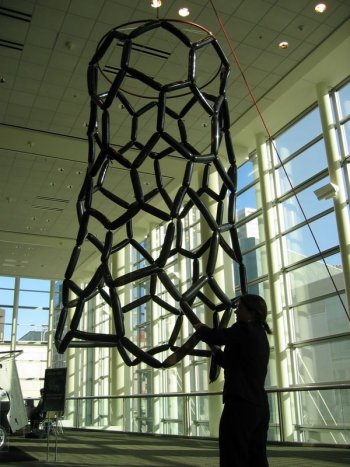- By Hester Vermaak
- Around Town
 Print
Print  Photo by Gary HodgesITHACA, NY — The Sciencenter will host the celebration of a new blockbuster summer exhibition, “Too Small to See,” that was developed and built right here in Ithaca. The event on Saturday, June 30, signals the kick-off of a summer long exploration of things at the atomic scale.
Photo by Gary HodgesITHACA, NY — The Sciencenter will host the celebration of a new blockbuster summer exhibition, “Too Small to See,” that was developed and built right here in Ithaca. The event on Saturday, June 30, signals the kick-off of a summer long exploration of things at the atomic scale.Charlie Trautmann, Sciencenter executive director, said, “We envision that advances in nanotechnology are likely to change the way we design and fabricate almost everything – from faster computers with greater storage capacity to stain repellent clothes to things that are still beyond our imagination.”
The subject matter might be too small to see, but the opening event and exhibition will provide a wide variety of large-scale, immersive experiences. On opening day, visitors can help create a giant model of a carbon nanotube out of balloons. The balloon model will reach from the museum lobby all the way to the Sciencenter’s second floor. Visitors are invited to a short presentation at 2 p.m. in the Sciencenter’s Amphitheater to learn more about these tiny structures called carbon nanotubes before they head out to the lobby to participate in the giant balloon activity.
Throughout the afternoon, from noon to 4 p.m., visitors can participate in hands-on activities and demonstrations introducing them to the world at the nanoscale. Families can explore the amazing properties of memory metal, liquid crystals and magnetic fluid. Children can dress up like nano scientists in head-to-toe “bunny suits.” Visitors are encouraged to bring their own cameras to take photos of their children in the “bunny suits.” A limited number of instant cameras will be available for purchase in the museum’s gift shop.

“Too Small to See” was developed through a partnership of Cornell University, the Sciencenter and Painted Universe, Inc. with funding from the National Science Foundation. At five-thousand square feet, the exhibition offers visitors a wide variety of experiences as they zoom into the world of nanotechnology.
Sciencenter exhibits developer, Stephen Hale, who worked on the project for more than two years said, “All of the exhibits are really fun, but my favorites are the ones where you zoom down to the nano level of a real image like a butterfly’s wing and an oyster shell. It just gives you a new appreciation of how beautiful everyday objects are at that scale.”
Visitors can not only zoom into the nano world, but they can immerse themselves in models of atoms and molecules that are enlarged to 100 million times their actual size. “Too Small to See” features full body interactive video installations where visitors can use their hands to grab and pull apart the ends of a virtual RNA molecule. When they let go, the molecule folds back up into its natural shape. Visitors can also dissolve a virtual salt crystal using their body’s movement to generate heat.
Visitors will discover that molecules are too small to see, but not too small to smell. Families can use their senses to lead them on a nano journey from small (sand), to smaller (dust), to nano (smell). Visitors can also experience the constant motion of atoms and molecules in a variety of exhibits, including the “Atom Transporter” where the challenge is to arrange individual atoms into a pattern while they move. Families will have a chance to view, build and stretch molecules while exploring their shape and structure.
Throughout the summer months, Cornell University scientists will give special Saturday presentations and demonstrations about nanotechnology at the Sciencenter. Details will be announced on the Sciencenter’s web site, www.sciencenter.org later this summer.
In mid-September “Too Small to See” will resume its national tour to other science and children’s museums nationwide, introducing more people to nanotechnology through hands-on exploration. When this exhibition hits the road in the fall, watch for the arrival of a new exhibition at the Sciencenter, “Japan and Nature: Spirits of the Seasons.”
----
v3i22



